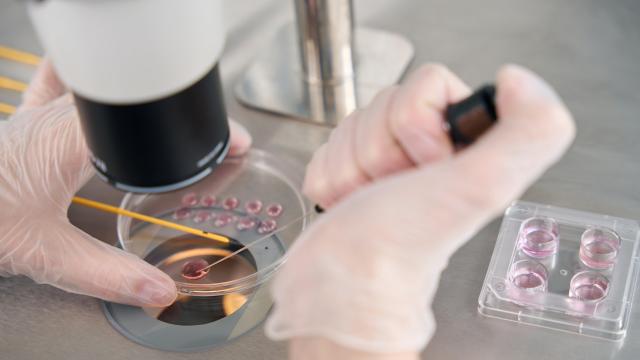A team of scientists in Israel say they’ve accomplished an incredible feat of biology: The creation of a completely human-like embryo model without the need for a sperm or egg. The synthetic embryos were grown using stem cells instead and appeared to have the same structures and components of a typical human embryo up through 14 days of development. The team believes their work will help us better understand the earliest stages of pregnancy and could even one day pave the way for breakthroughs in organ transplantation and other fields of medicine.
The research was led by scientists from the Weizmann Institute of Science. The group is one of several teams around the world that’s working on growing more complex synthetic embryos. Last summer, they published a study showing their creation of mice embryos derived entirely from mouse stem cells—mere weeks before another team from the UK published findings on their own mice model. Now, they seem to have done the same with human stem cells.
Stem cells are often considered the building block of life since they mature into other types of cells. However, not all stem cells have the same potential. Pluripotent stem cells, for instance, are known for their ability to turn into many, but not every type of cell. These cells play a large role relatively early on in helping the human body develop. Scientists have known for a while how to convert adult stem cells into their pluripotent state. But the Weizmann group has gone further, learning how to convert these cells into their earliest “naïve” state, cells that theoretically can become every other cell in the body. And it’s these naïve cells that are at the forefront of the team’s project.
To create their lab-made embryos, the team mixed together three groups of stem cells. One group was allowed to grow unperturbed, serving as the embryo itself. The two other groups were chemically prodded into becoming the parts of the structure that are meant to support the embryo, such as the placenta and yolk sac. The team’s experiments produced many clumps of stem cells, most of which failed to develop. But about one percent of these clumps kept growing and organizing themselves into something that could truly be considered an embryo, the researchers say.
These stem cell-based embryo-like structures, or SEMS, were purportedly able to grow in the lab for about 8 days. By that point, the SEMS seemed to have all the necessary components of a typical embryo that has reached 14 days of growth in the womb, the stage right before the embryo begins to develop what will eventually become organs. The researchers even performed pregnancy tests on their SEMS, since these tests rely on detecting a hormone produced by the embryo, and the tests came back positive.
The team’s findings were published Wednesday in Nature.
Scientists today can develop already created embryos in the lab to a certain extent, as well as produce artificial but simplistic models of embryos or individual organs. But these models still don’t allow us to closely look at the earliest stages of human development. And the authors say their work can do just that.
“The drama is in the first month, the remaining eight months of pregnancy are mainly lots of growth,” said study author and research leader Jacob Hanna in a statement from the Weizmann Institute. “But that first month is still largely a black box. Our stem cell-derived human embryo model offers an ethical and accessible way of peering into this box. It closely mimics the development of a real human embryo, particularly the emergence of its exquisitely fine architecture.”
One of the initial hopes of this research is that we can learn more about why miscarriages occur, which most commonly happen in the first trimester. These models could also make it easier for scientists to study how drugs or other exposures can potentially affect a fetus. Eventually, these advances might even enable us to create fully working organs in the lab that can be used for transplantation.
Here Are The Cheapest NBN 250 Plans You Can Get Right Now
Whether you’ve got the need for speed or simply looking for a better deal, these are the best prices going right now for the NBN 250 speed tier.
